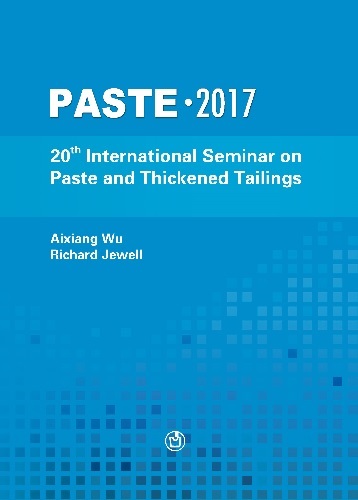Bleeding characteristics and improved mechanism of self-flowing tailings filling paste with low concentration

|
Authors: Liu, J; Wu, R; Wu, A; Wang, S |
DOI https://doi.org/10.36487/ACG_rep/1752_19_Liu
Cite As:
Liu, J, Wu, R, Wu, A & Wang, S 2017, 'Bleeding characteristics and improved mechanism of self-flowing tailings filling paste with low concentration', in A Wu & R Jewell (eds), Paste 2017: Proceedings of the 20th International Seminar on Paste and Thickened Tailings, University of Science and Technology Beijing, Beijing, pp. 162-169, https://doi.org/10.36487/ACG_rep/1752_19_Liu
Abstract:
In order to solve the bleeding problem of self-flowing tailings filling paste with low concentrations, the influences of the dosage of special additives on the bleeding rate were investigated. The improving mechanism of special additives on the bleeding of tailings filling paste was studied by measuring the bleeding rate and compressive strength of the paste and analyzing the scanning electron microscope (SEM), energy dispersive spectrometer (EDS) and infrared spectroscopy (IR) of the hardened paste. The results show that when the paste concentration is 60%, the binder-to-tailings ratio is 1:6, and the dosage of special additive is 10%, the filling paste is not bleeding and the compressive strength of the hardened paste can increase by 43.5% at 3 days. A large amount of needle-like ettringite is generated in the hardened paste after adding the special additives, and the structure becomes denser. The special additives can effectively improve the bleeding of the filling paste and increase the compressive strength of the filling material at early age.
References:
Dedong, L. 1984, ‘Infrared Spectroscopic Study of Sulphoaluminate Cement’, Journal of the Chinese ceramic society, vol. 12, no. 1, pp. 119-125.
Fall, M., Adrien, D., Celestin, J.C. 2009, ‘Saturated hyedraulic conductivity of cemented paste backfill’, Minerals Engineering, vol. 22, no. 15, pp. 1307-1317.
Fusi, L., Farina, A., Rosso, F. 2012, ‘Flow of a bingham-like fluid in a finite channel of varying width: a two-scale approach’, Journal of Non-Newtonian Fluid Mechanics, vol. 177, pp. 76-88.
Peyronnard, O., Benzaazoua, M. 2012, ‘Alternative by-product based binders for cemented mine backfill: recipes optimisation using taguchi method’, Minerals Engineering, vol. 29, pp. 28-38.
Syrakos, A., Georgiou, G.C., Alexandrou, A.N. 2013, ‘Solution of the square lid-driven cavity flow of a bingham plastic using the finite volume method’, Journal of Non-Newtonian Fluid Mechanics, vol. 195, pp. 19-31.
Wang, Y., Wang, H.J., Wu, A.X. 2011 ‘Research of fine tailings bleeding characteristics and influence factors’, Gold, vol. 32, no. 9, pp. 51-54.
Wu, D., Cai, S.J. Yang, W. 2012 ‘Simulation and experiment of backfilling pipeline transportation of solid-liquid two-phase flow based on CFD’, The Chinese Journal of Nonferrous Metals, vol. 22, no. 7, pp. 28-33.
Zhai, Y.G., Wu, A.X., Wang, H.J. 2011 ‘Threshold mass fraction of unclassified-tailings paste for backfill mining’, Journal of University of Science and Technology Beijing, vol. 33, no. 7, pp. 795-799.
Zhang, T., Ma, M., Wang, H., 2011 ‘A nonlinear rheological model of backfill material for retaining roadways and the analysis of its stability’, Mining Science and Technology (China), vol. 21, no. 4, pp. 543-546.
© Copyright 2026, Australian Centre for Geomechanics (ACG), The University of Western Australia. All rights reserved.
View copyright/legal information
Please direct any queries or error reports to repository-acg@uwa.edu.au
View copyright/legal information
Please direct any queries or error reports to repository-acg@uwa.edu.au